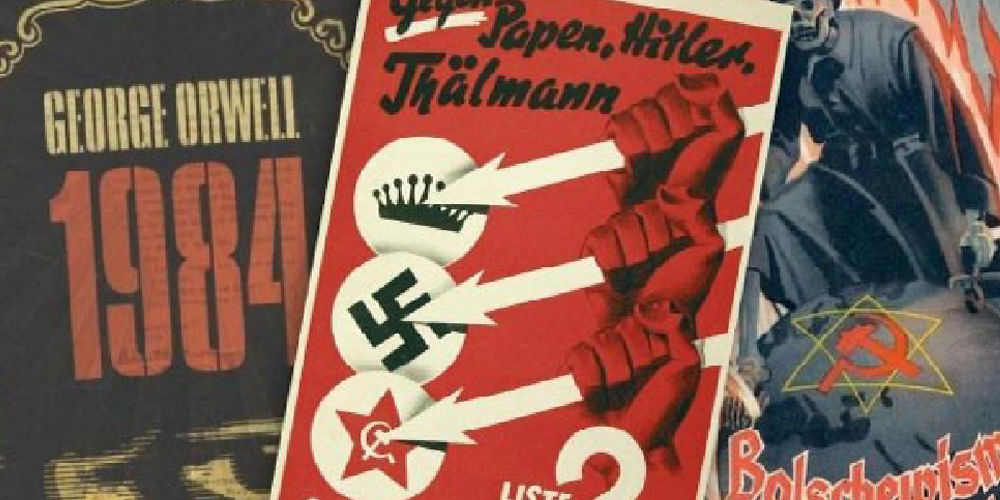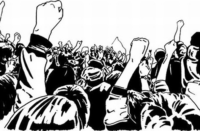■ From Manifest, monthly paper of the New Communist Party of the Netherlands,¹ translated and edited by Miranda Lynch.
Anti-communism is an essential part of the prevailing ideology under capitalism. It is of great importance to the bourgeoisie that the oppressed class does not see communism as an alternative. This anti-communism changes with time. First the communists were considered authoritarian by the liberals and anarchists; then communism was accused by fascists of spreading “Judaeo-Bolshevism.”
Today there is a very popular term for attacking communism: “totalitarianism.” This article looks at how totalitarianism has been popularised, and how this theory is being used in practice.
Use of the term in academia and in politics
“Totalitarianism” as a term is used to equate communism with fascism. The ruling class propagates the anti-communist theory of totalitarianism in various ways. Let’s take a look at three examples of “totalitarianism” being used to attack communism.
1. Civilian governments (often formed by far-right parties) use the theory of totalitarianism to ban communist parties and communist symbols. Romania and Poland banned the Communist Party in 2014 and 2019, respectively, on the grounds of “propagating a totalitarian system.” In Ukraine, “decommunisation” laws have banned not only the Communist Party but also all communist symbols.
The irony is that in Poland, Ukraine and Romania the governments often collaborate with far-right parties and groups that are openly fascist. These organisations are not allowed to exist on their own but often sit in government bodies, while communists are deprived of their freedom of organisation.
2. Totalitarianism is used by the European Union to demonise communism. In 2019 a resolution was passed by the European Union accusing the Soviet Union of starting the Second World War with Nazi Germany. Part of the resolution goes like this:
“… that the Second World War, the most devastating war in Europe’s history, was started as an immediate result of the notorious Nazi-Soviet Treaty on Non-Aggression of 23 August 1939, also known as the Molotov-Ribbentrop Pact, and its secret protocols, whereby two totalitarian regimes that shared the goal of world conquest divided Europe into two zones of influence.”²
This resolution uses “totalitarianism” to directly compare Nazi Germany and the Soviet Union. Reference is made to an alleged “collaboration” in which the Soviet Union and the Nazis would divide the world. It claims that Western European countries were the only “good” countries in the Second World War, while the communists entered into an alliance with the Nazis.
In reality it was the Western European countries that first signed non-aggression pacts with Germany. In fact the Soviet Union tried several times in the 1930s to form an alliance with the United Kingdom and France to deter the Nazis. These requests were all denied. Only after the Munich Agreement, whereby France and England allowed Hitler to annex parts of Czechoslovakia, did the Soviet Union conclude a non-aggression pact with Nazi Germany. This treaty was a necessity: the French and English clearly showed their hope that Hitler would attack the Soviet Union first.
3. In universities and schools, totalitarianism is used to attack communism. In the Netherlands, the secondary school curriculum for history contains the line “Putting into practice the totalitarian ideologies of communism and fascism / national socialism.” History teachers are expected to be able to explain to pupils how communism and (Nazi) fascism are related in the context of totalitarianism. And pupils are expected to be able to apply this theory during their final exam.
Totalitarianism: meaning and origin of the term
The idea of “totalitarianism” was popularised by Hannah Arendt in her book The Origins of Totalitarianism. Arendt tries to find different characteristics that make up a “totalitarian regime” by giving aspects and characteristics with which she tries to compare Nazism and “Stalinism.” She mentions, among other things, the following: a one-party system, led by one person, with an ideology, violent police, the presence of concentration camps, a monopoly over the media, and a centrally planned economy.
A comparison is made between Hitler and Stalin, without looking at the actual power the two leaders had. Arendt makes the argument that in both countries the individual is pushed aside in favour of a “mass,” without taking into account the differences between the Russian Revolution and capitalist society in Germany.
The book also compares the centrally planned economy of the Soviet Union with German macro-economic policies. The actual functioning of the economy, its relations of production and the mode of production are all ignored. In this way Arendt manages to equate a socialist economy with a capitalist one! That in one economy industrial magnates enriched themselves by appropriating all profits while the other economy planned to improve the conditions of the working class was apparently not interesting to Arendt.
The book also looks at the one-party system without looking at the related material circumstances that led to such a system. That the Nazis seized power in the bourgeois Weimar Republic, while the Soviets had to build their state on the ruins of Tsarism, after a devastating civil war and famine, is something Arendt ignores.
These comparisons are essentially very vague and meaningless. Despite this, they are seen by Arendt as the decisive factors that make up a totalitarian state. At the same time Nazi Germany’s eugenic and racial policies are ignored and not compared to the policies of the Soviet Union. This is because the Soviet Union ensured the self-determination of all kinds of oppressed nationalities, who were oppressed by Tsarism.
The October Revolution also brought enormous progress for oppressed minorities, and women. If Arendt had stated these facts in her book it would immediately become clear to most readers how nonsensical her comparison is.
Can the theory of totalitarianism be useful?
“Totalitarianism” is used by fascists to attack communism. Because the National Socialist Party no longer exists, groups that are ideologically very close to the Nazis can distance themselves from it by comparing them to the Soviet Union as “totalitarian regimes.” This allows these groups to legitimise themselves as an alternative for the population.
In many cases the term is also used by so-called “socialists” who use this term to distance themselves from actually existing socialism. Equating “Stalinism” and Nazi-fascism allows them to present themselves as the only possible option for the working class. The goal is to weaken the position of communists so that they can sell their reformist policies to the workers. This is great for the capitalists, because they know that if these opportunists come to power their own position as the ruling class will remain untouched.
There are many countries that have similarities with the Nazis, in that they occupy and plunder countries, destroy entire populations, oppress minorities, oppress women, terrorise workers with police brutality, and have capitalist monopolies in the media. It is the capitalist countries that do this, not the socialist countries. They do this not because they are “totalitarian” but because capitalism is based on exploitation and oppression. Only by making a materialist and dialectical analysis of a society, taking into account the class struggle, can you study and understand concrete social relations.
It is the task of the communist movement to study actually existing socialism and to draw lessons from these experiences. For us communists it is also a historic task to defend the struggle of all our comrades from anti-communist lies. A “theory” equating the Soviet Union and Nazi Germany is just as useful to society as the bourgeoisie that embraces this “theory” and belongs in the dustbin of history.
1. Tião Marighella, “Totalitarisme”: Een anticommunistische theorie,” Manifest, no. 8 (tinyurl.com/57vn3m2p)
2. European Parliament, “Importance of European remembrance for the future of Europe” (tinyurl.com/46bcuznd)






